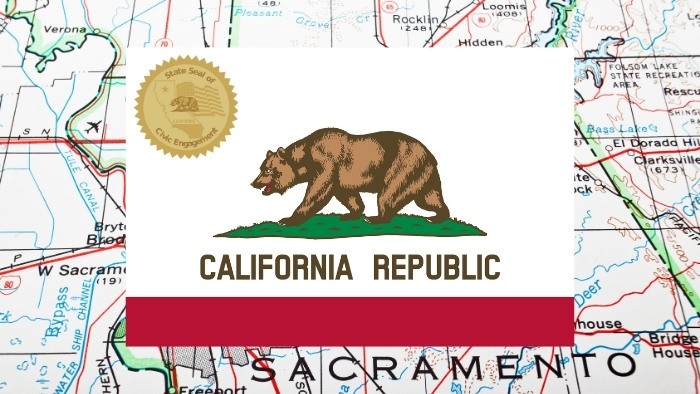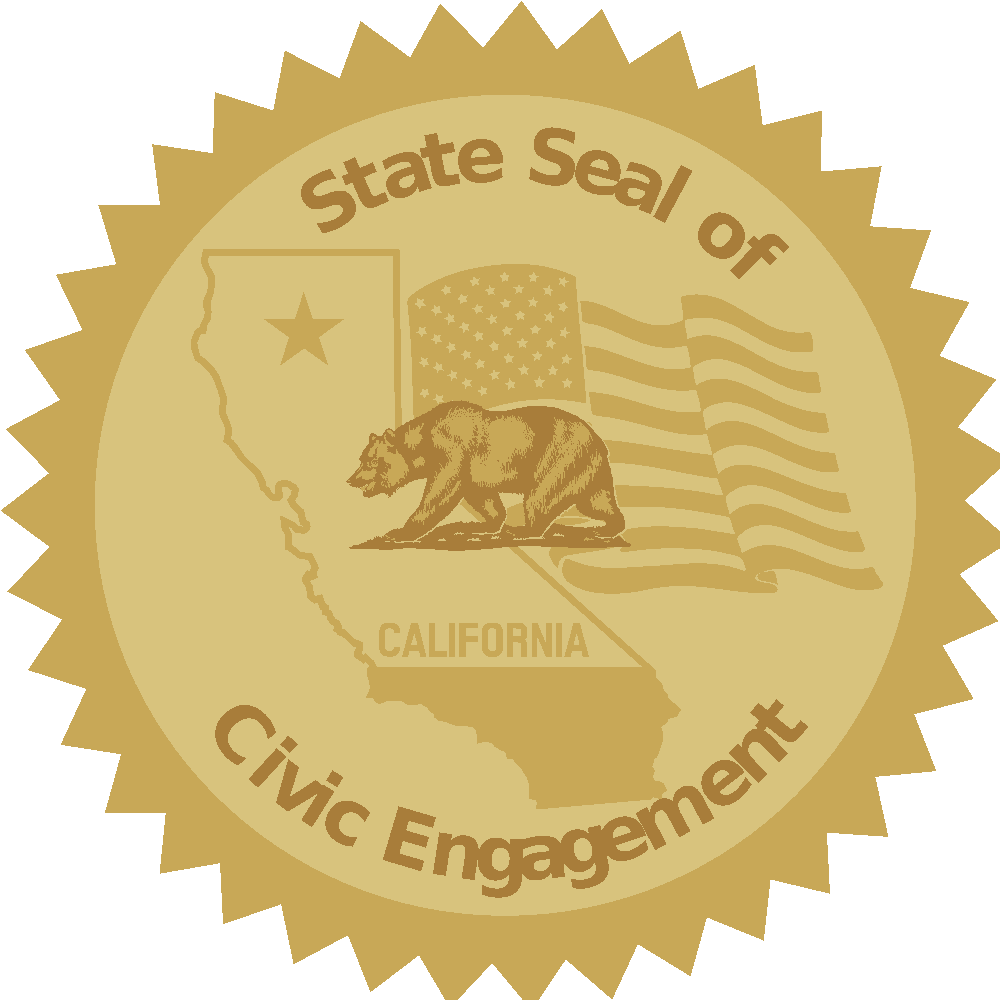Civic Education

Are California Students Prepared for Citizenship?
Some students are deeply involved in civic life. They may have participated in student government or taken an active role with their school’s PTSA. They may have campaigned for a local candidate or helped organize a grassroots effort to address an issue they care deeply about. They may have taken every course their high school offers on history, government and politics or even finished all the lessons about California education available here on Ed100.
Until now, however, the state did not provide any recognition for students’ civic learning and engagement. Nor did it keep track of which students, in which schools and districts, had these kinds of opportunities. That is changing, thanks to the creation of the State Seal of Civic Engagement.
What is the California State Seal of Civic Engagement?

The State Seal of Civic Engagement is a new, voluntary program for California schools and districts. The idea is to incentivize civic learning in local communities by creating official recognition that goes on a high school diploma.
Schools that want to provide this state recognition to their graduates have to assure that students meet five state criteria (see box).
|
Criteria for Earning the State Seal of Civic Engagement |
|---|
|
Be engaged in academic work in a productive way (as locally defined). |
|
Demonstrate a competent understanding of U.S. and California constitutions; functions and governance of local governments; tribal government structures and organizations; the role of the citizen in a constitutional democracy; and democratic principles, concepts, and processes (through successful completion of appropriate coursework). |
|
Participate in one or more informed civic engagement project(s) that address real-world problems and require students to identify and inquire into civic needs or problems, consider varied responses, take action, and reflect on efforts. |
|
Demonstrate civic knowledge, skills, and dispositions through self-reflection (such as an essay or presentation). |
|
Exhibit character traits that reflect civic-mindedness and a commitment to positively impact the classroom, school, community and/or society. |
Within that framework, local communities design their own programs and decide what opportunities they will provide for their students. The state has developed an Implementation Guide that offers ideas for what to include. Those who have worked on the Seal emphasize that civic education and engagement should be part of the curriculum at every age, going well beyond the current minimum expectation that students take a one-semester high school course in American Government.
One example of such an opportunity is student government, which can have a transformative impact on many students. Rowan Howell, an Ed100 graduate who is involved in student government in Riverside County and is also a student member of the California State PTA Board of Managers, recently talked about the value of this experience.
“Student Government has taught me the value of positive relationships and the true impact you have on others whether you know it or not. I have become a more outspoken person, better communicator and have been able to work towards becoming the leader I want to be … I have seen it bring students from completely different walks of life to work together and be there for each other through things as simple as setting up events to having deep and real conversations … I have been lucky enough to be able to connect with my peers through [student government] and have had the opportunity to improve my school as a small means of giving back.”
What needs to happen to adopt the State Seal locally?
When school districts adopt the Seal, they can use it to recognize students like Rowan who are already involved in local civics activities. (Incidentally, Rowan also attended the 2020 Ed100 Student Academy.) That recognition can help increase local attention to democratic education, which should in turn give all students better access to these opportunities.
But deciding to adopt the Seal is just the first step.
District officials need to put together a process that identifies the civic and democratic goals the community shares. Then they need to create a comprehensive plan for actually making robust learning opportunities available.
The State Seal of Civic Engagement Roadmap, developed by a volunteer task force, urges districts to start by organizing public deliberation regarding goals. Ideally, students, educators, school and district leaders, school board and community members participate, and participants reflect the diversity of the community. The Roadmap also recommends that districts ensure adequate staffing and stakeholder support to guide implementation, combined with an assessment of local assets—such as community groups and civic leaders—able to help.
Actively teaching students about citizenship can raise controversial issues, particularly when political discourse in this country has become so contentious. To address that challenge for educators, the National Endowment for the Humanities and the U.S. Department of Education have instituted the Educating for American Democracy initiative and laid out principles to help guide K-12 civics and history instruction. It’s worth your time to see what this bipartisan initiative has created.
Making the case for civic learning
California public schools have the responsibility to create an informed citizenry, well-prepared for democratic participation. Official state guidance to schools underscores its importance. When state leaders updated the California Framework for History-Social Science in 2016, they explicitly included civic education. Appendix E of the document states “Preparing students for informed, skilled and engaged participation in civic life is a key goal of social studies education.” The state’s description of high-quality civic education programs says that students should have the opportunity to:
- Discuss and deliberate current issues;
- Participate in simulations and activities that model governmental processes and policymaking;
- Engage in civics-based service learning; and
- Participate in school governance and extracurricular activities that encourage civil discourse, working together and consensus building.
There is substantial research about the many benefits for students when schools make high-quality, school-based civic learning a priority. A 2013 study, summarized by the Education Commission of the States (ECS), identified benefits in five areas:
|
Benefits of Civic Education |
|
|---|---|
|
Foster civic knowledge, skills, and attitudes |
These attributes collectively prepare students for informed, effective participation in our democracy. |
|
Promote civic equality |
Voter turnout is highest among white, affluent, highly educated Americans, and universally available civic learning opportunities close this empowerment gap. |
|
Build 21st century skills |
Students in traditional and interactive civics lessons work well with others, are economically knowledgeable, media literate, and aware of current events. |
|
Improve school climate |
Through civic engagement activities, young people connect with the community, learn respectful dialogue, teamwork, and appreciate diversity. |
|
Lower drop-out rates |
Real-world civic learning opportunities improve students’ chances of staying in school. |
Do you believe that schools need to prepare all students for citizenship? Encouraging local adoption of the State Seal provides a perfect opportunity to walk your talk.
You can start by finding out whether your district plans to adopt the State Seal. If district officials say yes, ask how the community will be included in the process and volunteer to help. If they say no, or not at this time, maybe you can build a coalition to build awareness and attention for the idea. You might want to enlist the support of faculty champions, such as history-social science teachers or like-minded elementary teachers.
As is so often true, active vocal parents and students can act as catalysts for an initiative like the State Seal. It’s called civic engagement.
 Mary Perry, an independent education consultant and longtime advisor for Ed100.org, has served many leadership roles for the California State PTA including Vice President for Education. She delivered an essential presentation at the 2020 Ed100 Academy for Student Leaders to help bring students to a shared level of understanding of the education system, and she is a confirmed speaker for the 2021 Student Academy.
Mary Perry, an independent education consultant and longtime advisor for Ed100.org, has served many leadership roles for the California State PTA including Vice President for Education. She delivered an essential presentation at the 2020 Ed100 Academy for Student Leaders to help bring students to a shared level of understanding of the education system, and she is a confirmed speaker for the 2021 Student Academy. Tags on this post
Civics Student voiceAll Tags
A-G requirements Absences Accountability Accreditation Achievement gap Administrators After school Algebra API Arts Assessment At-risk students Attendance Beacon links Bilingual education Bonds Brain Brown Act Budgets Bullying Burbank Business Career Carol Dweck Categorical funds Catholic schools Certification CHAMP Change Character Education Chart Charter schools Civics Class size CMOs Collective bargaining College Common core Community schools Contest Continuous Improvement Cost of education Counselors Creativity Crossword CSBA CTA Dashboard Data Dialogue District boundaries Districts Diversity Drawing DREAM Act Dyslexia EACH Early childhood Economic growth EdPrezi EdSource EdTech Education foundations Effort Election English learners Equity ESSA Ethnic studies Ethnic studies Evaluation rubric Expanded Learning Facilities Fake News Federal Federal policy Funding Gifted Graduation rates Grit Health Help Wanted History Home schools Homeless students Homework Hours of opportunity Humanities Independence Day Indignation Infrastructure Initiatives International Jargon Khan Academy Kindergarten LCAP LCFF Leaderboard Leadership Learning Litigation Lobbyists Local control Local funding Local governance Lottery Magnet schools Map Math Media Mental Health Mindfulness Mindset Myth Myths NAEP National comparisons NCLB Nutrition Pandemic Parcel taxes Parent Engagement Parent Leader Guide Parents peanut butter Pedagogy Pensions personalized Philanthropy PISA Planning Policy Politics population Poverty Preschool Prezi Private schools Prize Project-based learning Prop 13 Prop 98 Property taxes PTA Purpose of education puzzle Quality Race Rating Schools Reading Recruiting teachers Reform Religious education Religious schools Research Retaining teachers Rigor School board School choice School Climate School Closures Science Serrano vs Priest Sex Ed Site Map Sleep Social-emotional learning Song Special ed Spending SPSA Standards Strike STRS Student motivation Student voice Success Suicide Summer Superintendent Suspensions Talent Teacher pay Teacher shortage Teachers Technology Technology in education Template Test scores Tests Time in school Time on task Trump Undocumented Unions Universal education Vaccination Values Vaping Video Volunteering Volunteers Vote Vouchers Winners Year in ReviewSharing is caring!
Password Reset
Search all lesson and blog content here.
Login with Email
We will send your Login Link to your email
address. Click on the link and you will be
logged into Ed100. No more passwords to
remember!














Questions & Comments
To comment or reply, please sign in .
Kim Trutane March 29, 2021 at 6:21 pm